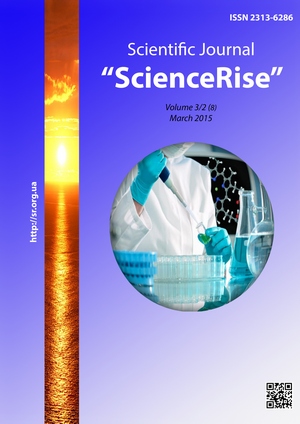Модельне відображення створення фронтальних шарів пористого кремнію для сонячних елементів
DOI:
https://doi.org/10.15587/2313-8416.2015.39154Ключевые слова:
антивідбивне покриття, пористий кремній модельне представлення, електрохімічне травлення, фотоелектричний перетворювачАннотация
Для отримання фронтальних функціональних шарів сонячних елементів (СЕ) був зроблен глибокий аналіз існуючих моделей пористого кремнію. Відібрані моделі, максимально дієві для створення ефективного та рентабельного покриття на основі пористого кремнію (ПК) і максимально адаптовані до процесів створення кремнієвих сонячних елементів. Використання шарів ПК, отриманих на основі модельного представлення, спростить технологічний цикл, зменшить вартість виробу та підвищить експлуатаційні характеристики, тобто дозволить підвищити ефективність технології виготовлення сонячних елементів
Библиографические ссылки
Liena, S.-Y., Wuua, D.-S., Yeh, W.-C. (2006). Tri-layer antireflection coatings (SiO2/SiO2–TiO2/TiO2) for silicon solar cells using a sol–gel technique. Solar Energy Materials & Solar Cells, 90 (16), 2710–2719. doi: 10.1016/j.solmat.2006.04.001
Canham L. T. (1990). Porous silicon multilayer optical waveguides. Appl. Phys. Lett, 57, 1046.
Prokes, S. M., Glembocki, O. J., Bermudez, V. M., Kaplan, R. (1992). SiHx excitation: An alternate mechanism for porous Si photoluminescence. Physical Review B, 45 (23), 13788. doi: 10.1103/physrevb.45.13788
Brandt, M. S., Fuchs, H. D., Stutzmann, M., Weber, J., Cardona, M. (1992). Structural and Optical Properties of Porous Silicon Nanostructures. Solid State Commun, 81, 307.
Koch, F. (1993). Porous Silicon: Material, Technology and Devices. Mater. Res. Sot. Symp. Proc., 298, 319.
Witten, T. A., Sander, L. M. (1983). Diffusion-limited aggregation. Physical Review B, 27 (9), 5686–5697. 10.1103/physrevb.27.5686
Smith, R. L., Collins, S. D. (1989). Generalized model for the diffusion-limited aggregation and Eden models of cluster growth. Physical Review A, 39 (10), 5409–5413. doi: 10.1103/physreva.39.5409
Parkhutik, V. P., Shershulsky, V. I. (1992). Theoretical modeling of porous oxide growth on aluminium. Journal of Physics D: Applied Physics, 25 (8), 1258–1263. doi: 10.1088/0022-3727/25/8/017
Carstensen J., Prange, R., Foil, H. (1999). A model for current-voltage oscillations at the silicon electrode and comparison with experimental results. Journal of The Electrochemical Society, 146 (3), 1134–1140. doi: 10.1149/1.1391734
Valance, A. (1997). Theoretical model for early stages of porous silicon formation from n- and p-type silicon substrates. Physical Review B, 55 (15), 9706–9715. doi: 10.1103/physrevb.55.9706
Kang, Y., Jorne, J. (1997). Dissolution mechanism for p-Si during porous silicon formation. Journal of The Electrochemical Society, 144 (9), 3104–3110. doi: 10.1149/1.1837966
Chazalviel, J.-N., Wehrspohn, R. B., Ozanam, F. (2000). Electrochemical preparation of porous semiconductors: from phenomenology to understanding. Materials Science and Engineering (B), 69-70, 1–10. doi: 10.1016/s0921-5107(99)00285-8
Emel'yanov, V. I., Eremin, K. I., Starkov, V. V. (2002). Defect-deformation mechanism of spontaneous nucleation of an ensemble of pores in solids and its experimental verification. Quantum Electronics, 32 (6), 473–475. doi: 10.1070/qe2002v032n06abeh002225
Emel'janov, V. I. (1999). Samoorganizacija uporjadochennyh defektno-deformacionnyh mikro- i nanostruktur na poverhnosti tverdyh tel pod dejstviem lazernogo izluchenija. Kvant, jelektronika, 27 (7), 2–18.
Walgraef, D., Ghoniem N. М., Lauzeral, J. (1997). Deformation patterns in thin films under uniform laser irradiation. Physical Review B, 56 (23), 15361–15377. doi: 10.1103/physrevb.56.15361
Emel'yanov, V. I. (1992). Generation-Diffusion-Deformational Instabilities and Formation of Ordered Defect Structures on Surfaces of Solids under the Action of Strong Laser Beams. Laser Physics, 2 (4), 389–466.
Lehmann, V. (1993).The physics of macropore formation in low doped n-type silicon. Journal of The Electrochemical Society, 140 (10), 2836–2843. doi: 10.1149/1.2220919
Lehmann, V., Ronnebeck, S. (2004). The physics of macropore formation in low-doped p-type silicon. Journal of The Electrochemical Society, 146 (8), 2968–2975. doi: 10.1149/1.1392037
Zhang, X. G. (2004). Morphology and Formation Mechanisms of Porous Silicon. Journal of The Electrochemical Society, 151 (1), 69–80. doi: 10.1149/1.1632477
Lehmann, V., Gosele, U. (1991). Porous silicon formation: A quantum wire effect. Applied Physics Letters, 58 (8), 856–858. doi: 10.1063/1.104512
Kompan, M. E., Kuzminov, E. G., Kulik, V. (1996). Observation of a compressed state of the quantum wire material in porous silicon by the method of Raman scattering. Journal of Experimental and Theoretical Physics Letters, 64 (10), 748–753.
Starkov, V. V., Starostina, E. A., Vyatkin, A. F., Volkov, V. T. (2000). Dielectric porous layer formation in Si and Si/Ge by local stain etching. Physica status solidi (a), 182 (1), 93–96. doi: 10.1002/1521-396x(200011)182:1<93::aid-pssa93>3.0.co;2-8
Yerokhov, V. Yu., Melnyk, I. I. (1999). Porous silicon in solar cell structures: A review of achievements and modern directions of further use . Journal: Renewable and Sustainable Energy Reviews, 3 (4), 291–322. doi: 10.1016/s1364-0321(99)00005-2
Huang, Y., Ma, Q.-L., Meng, M. (2011). Porous silicon based solar cells. Materials Science Forum, 663-665, 836–839. doi: 10.4028/www.scientific.net/msf.663-665.836
Foil, Н., Christophersen, М., Carstensen, J., Hasse, G. (2002). Formation and application of porous silicon. Materials Science and Engineering (R), 39, 93–141.
Загрузки
Опубликован
Выпуск
Раздел
Лицензия
Copyright (c) 2015 Валерій Юрійович Єрохов

Это произведение доступно по лицензии Creative Commons «Attribution» («Атрибуция») 4.0 Всемирная.
Наше издание использует положения об авторских правах Creative Commons CC BY для журналов открытого доступа.
Авторы, которые публикуются в этом журнале, соглашаются со следующими условиями:
1. Авторы оставляют за собой право на авторство своей работы и передают журналу право первой публикации этой работы на условиях лицензии Creative Commons CC BY, которая позволяет другим лицам свободно распространять опубликованную работу с обязательной ссылкой на авторов оригинальной работы и первую публикацию работы в этом журнале.
2. Авторы имеют право заключать самостоятельные дополнительные соглашения, которые касаются неэксклюзивного распространения работы в том виде, в котором она была опубликована этим журналом (например, размещать работу в электронном хранилище учреждения или публиковать в составе монографии), при условии сохранения ссылки на первую публикацию работы в этом журнале .

